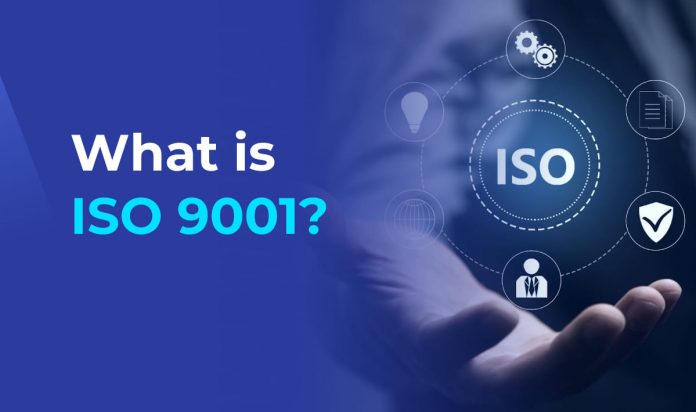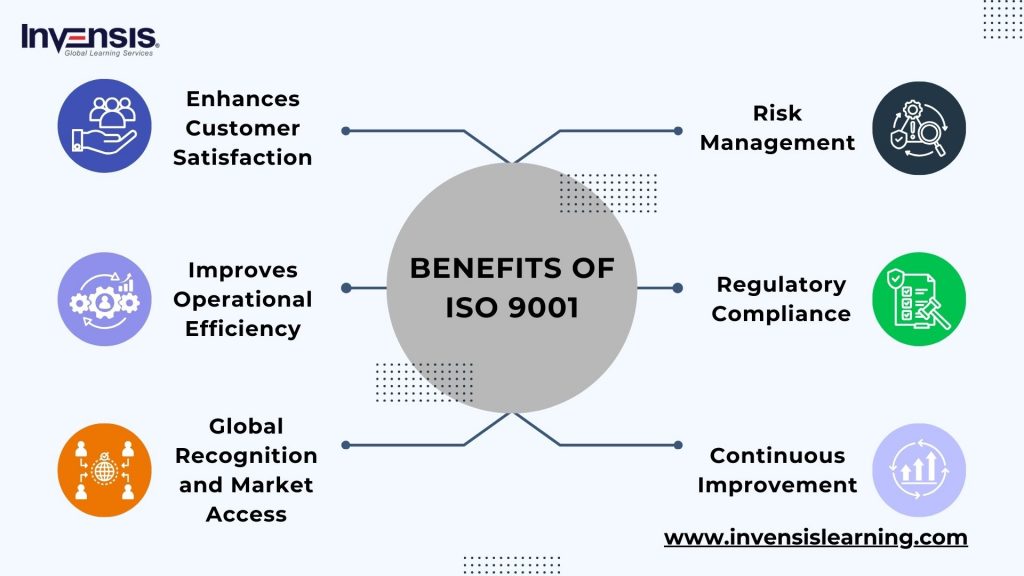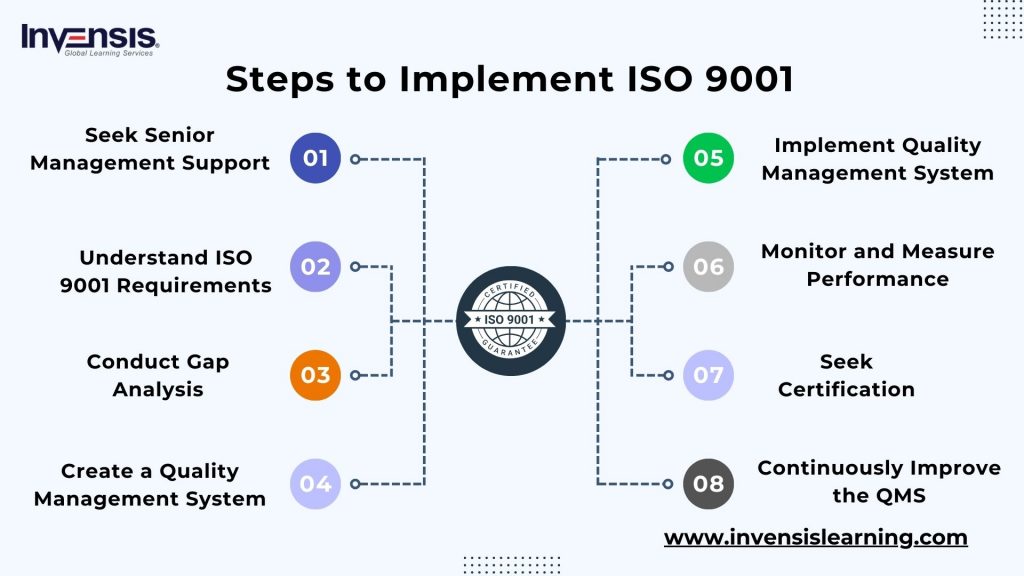
Ever wondered what makes a successful business truly thrive? It’s not just about the product or service; it’s about the foundation. Introducing ISO 9001, the international standard that helps organizations build a rock-solid system for exceptional quality management.
In this blog, we will explain ISO 9001 from scratch, which helps professionals to gain an in-depth understanding of it.
Whether you’re a seasoned entrepreneur or just starting, ISO 9001 has the potential to elevate your business to new heights. Stay tuned as we delve deeper into its definition, benefits, and implementation secrets.
Remember, quality isn’t an accident; it’s a system – and ISO 9001 is the key to unlocking it.
Ready to join the quality revolution? Buckle up, and let’s explore the amazing world of ISO 9001!
Table of Contents
- What is ISO 9001?
- Importance of ISO 9001
- What is the Current ISO 9001 Standard?
- Why to Implement ISO 9001?
- When to Implement ISO 9001?
- How to Implement ISO 9001?
- ISO 9000 vs ISO 9001
- Conclusion
- FAQs
What is ISO 9001?
ISO 9001:2015 is a globally recognized standard that sets out the quality management system (QMS) criteria. This standard, developed by the International Organization for Standardization (ISO), applies to companies of all sizes and industries.
It includes a set of criteria that firms may use to demonstrate their capacity to consistently produce products and services that meet consumer expectations and regulatory demands.
ISO 9001 emphasizes a systematic approach to managing quality, encompassing aspects such as leadership, engagement of personnel, and evidence-based decision-making.
By implementing the standard in the organization, organizations aim to enhance their overall efficiency, meet customer expectations consistently, and demonstrate a dedication to delivering high-quality products or services.
Key Principles of ISO 9001
- Customer Focus: Understand and meet customer needs, aiming to exceed expectations for enhanced satisfaction
- Leadership: Top management commitment, establishing organizational purpose, and fostering a quality-oriented environment
- Engagement of People: Empower and involve personnel at all levels, recognizing their significance in achieving Quality Management Systems (QMS) effectiveness
- Process Approach: Manage activities as interconnected processes, promoting systematic identification and improvement
- Continuous Improvement: Commitment to continual enhancement, addressing non-conformities, and implementing corrective actions
- Evidence-Based Decision Making: Rely on relevant data and information for informed decision-making and performance evaluation
- Relationship Management: Establish and manage relationships with stakeholders to achieve common objectives
Importance of ISO 9001
The importance of ISO 9001 lies in its role as a globally recognized and widely adopted standard for Quality Management Systems (QMS). Organizations that implement and adhere to the standard demonstrate a commitment to maintaining high-quality standards in their products and services.
Here are the key benefits of ISO 9001:
- Enhances Customer Satisfaction: ISO 9001 places a strong emphasis on meeting customer requirements and enhancing satisfaction. Organizations strive to consistently deliver products and services that meet or exceed customer expectations by implementing the standard
- Improves Operational Efficiency: It promotes a process-oriented approach to quality management. This helps organizations streamline their operations, identify areas for improvement, and implement systematic processes, leading to increased efficiency and reduced waste
- Global Recognition and Market Access: ISO 9001 certification is globally recognized, providing organizations with a competitive edge in the international marketplace. Many customers and partners prefer to engage with businesses that have achieved ISO 9001 certification, facilitating market access and business opportunities
- Risk Management: The standard encourages organizations to identify and manage risks that could impact the quality of their products or services. This proactive approach to risk management helps prevent issues and ensures continuous improvement
- Regulatory Compliance: It helps organizations align with regulatory requirements and standards in their respective industries. This is crucial for businesses operating in sectors with stringent quality and safety regulations
- Continuous Improvement: The framework is built on the principle of continuous improvement. Organizations are encouraged to regularly assess and enhance their processes, leading to ongoing optimization and innovation
Enroll in Invensis Learning’s Quality Management Training Courses and master ISO 9001 standard for career growth!
What is the Current ISO 9001 Standard?
The current ISO 9001 standard is ISO 9001:2015. However, it’s important to note that as of September 2023, the International Organization for Standardization (ISO) Technical Committee 176, Sub-Committee 2, voted to start a revision of the standard immediately. This means a new version of the standard will likely be released within the next few years.
The present iteration of the standard is ISO 9001:2015, also known as ISO 9001 revision 2015, which was published in October 2015, supplanting the preceding ISO 9001:2008 revision.
This updated version encompasses several processes from its previous standard version but emphasizes risk-based thinking and a comprehensive understanding of the organization’s context.
Here’s a breakdown of the current situation:
-
ISO 9001:2015
This is the current version of the standard, and it was published in 2015. It is a set of requirements that organizations can use to demonstrate their ability to consistently deliver products and services that meet customer and regulatory demands.
Some of the key features of ISO 9001:2015 include a focus on risk-based thinking, the involvement of top management, and the importance of continuous improvement.
-
Revised ISO 9001
The specific details of the revised ISO 9001 standard are still being developed, but it is expected to include greater emphasis on emerging trends such as digitalization and automation. It is also possible that the revised standard will be more flexible to the needs of organizations of all sizes and industries.
Why implement ISO 9001?
Implementing ISO 9001 offers numerous benefits to organizations across various industries.
Here are key reasons why businesses choose to adopt and implement the standard:
- Implementing ISO 9001 ensures alignment with industry regulations and standards, reducing the risk of legal issues and fostering a culture of compliance
- The standard encourages organizations to optimize resources by identifying and addressing inefficiencies, leading to improved resource utilization and reduced waste
- ISO 9001 certification instills confidence among stakeholders, including customers, suppliers, and investors, strengthening relationships and business partnerships
- The emphasis on documentation and record-keeping promotes data-driven decision-making, enabling organizations to analyze performance and make informed strategic choices
- The standard fosters employee engagement by involving them in the quality management process, resulting in improved morale, job satisfaction, and a sense of ownership in quality outcomes
- ISO 9001 certification enhances a company’s competitiveness by signaling a commitment to quality, attracting customers who prioritize reliability and consistency
When to implement ISO 9001?
Implementing ISO 9001 offers numerous benefits to organizations across various industries.
Here are key reasons why businesses choose to adopt and implement the ISO 9001 standard:
- Implementing ISO 9001 standard ensures alignment with industry regulations and standards, reducing the risk of legal issues and fostering a culture of compliance
- The standard encourages organizations to optimize resources by identifying and addressing inefficiencies, leading to improved resource utilization and reduced waste
- ISO 9001 certification instills confidence among stakeholders, including customers, suppliers, and investors, strengthening relationships and business partnerships
- The certification enhances a company’s competitiveness by signaling a commitment to quality, attracting customers who prioritize reliability and consistency
- The emphasis on documentation and record-keeping promotes data-driven decision-making, enabling organizations to analyze performance and make informed strategic choices.
How to implement ISO 9001?
Implementing the world’s gold standard for quality management, can transform your organization into a powerhouse of efficiency, customer satisfaction, and continuous improvement.
But where do you start? The steps below will be your roadmap to success, breaking down the implementation process into clear, actionable steps.
Step: 1 Seek Senior Management Support
This initial step is crucial for successful ISO 9001 implementation. It involves obtaining commitment and support from senior management. Top-level executives play a key role in allocating resources, setting the tone for the organization’s commitment to quality, and ensuring that the QMS aligns with overall business objectives.
Step: 2 Understand ISO 9001 Requirements
Before implementation, it’s essential to understand the requirements outlined in the ISO 9001 standards thoroughly. This involves studying the standard clauses and understanding how they apply to the organization’s processes and objectives.
Step 3: Conduct Gap Analysis
A gap analysis involves assessing the current state of the organization’s processes against the requirements of ISO 9001. This helps identify areas where the organization already complies and areas that require improvement or additional processes to meet the standard.
Step 4: Create a Quality Management System
The organization can create a comprehensive Quality Management System (QMS) based on the gap analysis. This involves developing documented procedures, policies, and processes to meet ISO 9001 requirements. It also includes creating a Quality Manual that outlines the scope of the QMS.
Step 5: Implement Quality Management System
Once the QMS is established, it’s time to implement the documented processes and procedures across the organization. This may involve training employees, updating existing processes, and ensuring everyone understands their roles and responsibilities within the QMS.
Step 6: Monitor and Measure Performance
Ongoing monitoring and measurement of key performance indicators (KPIs) are crucial for assessing the effectiveness of the QMS. This step involves establishing processes to regularly collect and analyze data related to quality objectives, customer satisfaction, and other relevant metrics.
Step 7: Seek Certification
After successfully implementing the QMS and ensuring it effectively functions, the organization can engage an accredited certification body to conduct an external audit. If the organization complies with ISO 9001 requirements, it can obtain certification, signaling to stakeholders and customers that it meets international quality management standards.
Step 8: Continuously Improve the QMS
The standard emphasizes a culture of continuous improvement. Organizations are encouraged to regularly review their processes, gather feedback, and identify opportunities for enhancement. This ongoing improvement ensures that the QMS remains effective and aligned with the organization’s evolving goals and industry changes.
ISO 9000 vs. ISO 9001
Understanding the difference between ISO 9000 and ISO 9001 is crucial when considering quality management standards for your organization.
Here’s a breakdown:
| Aspect | ISO 9000 | ISO 9001 |
| Type | Family of standards encompassing a set of guidelines, principles, and terminology for quality management | Specific standards within the ISO 9000 family, focusing on the requirements for implementing a Quality Management System (QMS) |
| Purpose | Serves as a foundation, offering fundamental concepts and principles related to quality management | Provides a framework that organizations can follow to establish and maintain effective quality management practices |
| Focus | Focus is on general principles and terminology, providing an overview of the concepts involved in quality management | Places a specific emphasis on defining processes, procedures, and requirements that organizations need to fulfill to meet customer expectations and continually improve their processes |
| Application | Used as a starting point for organizations looking to build a foundational understanding of quality management concepts before pursuing specific Quality Management Systems (QMS) standards | Applied by organizations seeking certification for their QMS. It provides the detailed requirements that an organization must meet to achieve ISO 9001 certification |
| Certification | It is not a certification standard. Organizations cannot be certified to ISO 9000 | Implemented by organizations looking to establish a QMS that conforms to the specific requirements of the standard. It is the basis for achieving ISO 9001 certification |
Conclusion
In conclusion, ISO 9001 stands as a powerful framework for organizations of all sizes and industries to achieve excellence in quality management. It’s not just about ticking boxes and achieving certification; it’s about fostering a culture of continuous improvement, customer focus, and operational efficiency.
By implementing the standard, you’re investing in the long-term success of your organization. You’ll enhance customer satisfaction and brand reputation, boost internal performance, reduce costs, and gain a competitive edge in the marketplace.
So, are you ready to embark on your quality journey with ISO 9001? Take the first step today with Quality Management certification courses and unlock the potential for exceptional performance within your organization.
FAQs
What is ISO 9001?
It is an international standard that outlines the requirements for establishing and maintaining an organization’s Quality Management System (QMS).
What are the principles of ISO 9001?
ISO 9001 is guided by fundamental principles such as prioritizing customer needs, demonstrating effective leadership, engaging people, adopting a process-oriented approach, promoting continual improvement, making decisions based on evidence, and managing relationships.
Can ISO 9001 be applied to any industry?
Yes, ISO 9001 is applicable to organizations across various industries, including manufacturing, services, healthcare, education, and more. The standard is flexible and can be adapted to suit the specific needs of different sectors.
Is ISO 9001 certification right for my organization?
It depends on your specific needs and goals. Consider your size, industry, and commitment to quality management. If you’re looking to improve your quality practices and gain a competitive edge, ISO 9001 can be a valuable asset.
















